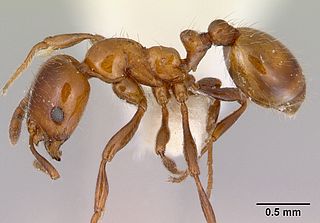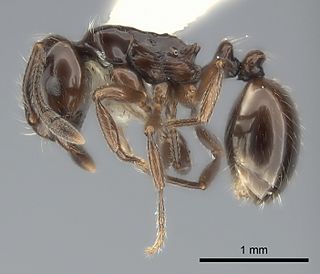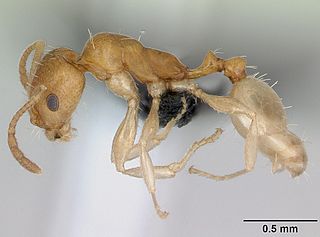
Myrmicinae is a subfamily of ants, with about 140 extant genera; their distribution is cosmopolitan. The pupae lack cocoons. Some species retain a functional sting. The petioles of Myrmicinae consist of two nodes. The nests are permanent and in soil, rotting wood, under stones, or in trees.

Tapinoma is a genus of ants that belongs to the subfamily Dolichoderinae. The genus currently comprises 74 described species distributed worldwide in tropical and temperate regions. Members of are generalized foragers, nesting in a wide variety of habitats, ranging from grasslands, open fields, woodlands, to inside buildings. The majority of species nest in the ground under objects such as stones or tree logs, other species build nests under bark of logs and stumps, in plant cavities, insect galls or refuse piles.

Monomorium antarcticum is an ant of the family Formicidae, endemic to New Zealand. Also known as the southern ant, this is likely New Zealand's most common native ant species. Because it is highly variable in size (3–5mm), colour, and colony structure, it is possible that it consists of a complex of closely related species. It has a generalist diet, including small arthropods, nectar, and seeds, and it also tends aphids, scale insects, and mealybugs to obtain honeydew.

Iridomyrmex is a genus of ants called rainbow ants first described by Austrian entomologist Gustav Mayr in 1862. He placed the genus in the subfamily Dolichoderinae of the family Formicidae. It has 79 described species and five fossil species. Most of these ants are native to Australia; others are found in Asia and Oceania, and they have been introduced to Brazil, New Zealand, and the United Arab Emirates. Fossil species are known from China, France, and the United States.

Gustav L. Mayr was an Austrian entomologist and professor in Budapest and Vienna. He specialised in Hymenoptera, being particularly known for his studies of ants.

Monomorium bidentatum is a species of ant in the subfamily Myrmicinae. It is endemic to two South American countries, Chile and Argentina.

Megalomyrmex is a genus of ant in the subfamily Myrmicinae. The genus is known only from the Neotropics, where some of the species are specialized parasites or predators of Attini.

Tetramorium inquilinum is an ectoparasitic ant found in Europe. It was discovered by Swiss myrmecologist Heinrich Kutter. The species is unusual for lacking a worker caste, the queens and males living entirely off the care of the pavement ant. It has been called "the 'ultimate' parasitic ant" by myrmecologists Edward O. Wilson and Bert Hölldobler.

Aenictus is a large army ant genus distributed in the Old World tropics and subtropics. It contains about 181 species, making it one of the larger ant genera of the world.

Diaphoromyrma is a genus of ants in the subfamily Myrmicinae. It contains the single species Diaphoromyrma sofiae, known only from workers from the type locality in Bahia, Brazil. The genus is apparently close to Allomerus and Diplomorium in the Solenopsidini, but its tribal attribution remains uncertain.

Agroecomyrmecinae is a subfamily of ants containing two extant and two fossil genera. The subfamily was originally classified in 1930 by Carpenter as Agroecomyrmecini, a Myrmicinae tribe. Bolton raised the tribe to subfamily status in 2003, suggesting that Agroecomyrmecinae might be the sister taxon to Myrmicinae. It has since been discovered to be one of the earliest lineages of ants, a clade from the basal polytomy for all ants. In 2014, the subfamily was expanded to two tribes. The tribe Ankylomyrmini was moved from the subfamily Myrmicinae to Agroemyrmecinae.

Carebara is a genus of ants in the subfamily Myrmicinae. It is one of the largest myrmicine genera with more than 200 species distributed worldwide in the tropics and the Afrotropical region. Many of them are very tiny cryptic soil and leaf-litter inhabitants. They nest in rotten wood to which the bark is still adherent in the Afrotropical region, or may be lestobiotic nesting near other ant species. Some species are known to exist parasitically within termite nests. Little is known about the biology of the genus, but they are notable for the vast difference in size between queens and workers.

Ankylomyrma is a genus of large arboreal ants in the subfamily Agroecomyrmecinae. It contains the single species Ankylomyrma coronacantha, the sole member of the tribe Ankylomyrmini. The genus is known from Africa. Nothing is known about their biology. The genus was moved from the subfamily Myrmicinae to Agroecomyrmecinae in 2014.

Tyrannomyrmex is a rare tropical genus of ants in the subfamily Myrmicinae. Three similar species, only known from workers, are recognized and share small eyes and edentate mandibles.

Royidris is a Malagasy genus of ants in the subfamily Myrmicinae. Described in 2014, the genus contains 15 species endemic to Madagascar.
Kempfidris is a Neotropical genus of ants in the subfamily Myrmicinae containing the single species Kempfidris inusualis. Known from Brazil, Ecuador and Venezuela, the species was originally described as Monomorium inusuale in 2007, but was reclassified as the type species for the new genus Kempfidris in 2014. The species is only known from workers and almost nothing is known about their natural history.

Trichomyrmex is a genus of ants in the subfamily Myrmicinae. Described by Mayr in 1865, it was raised as a genus in 2015. These ants are endemic to multiple continents.
















